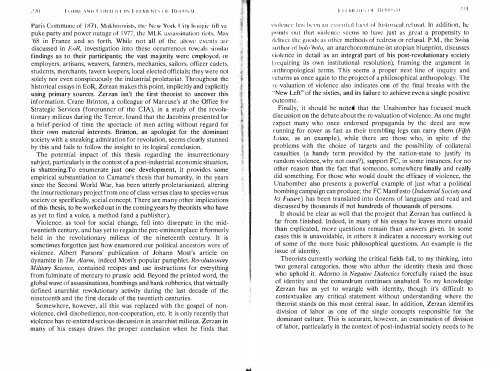CONTENTS - ouroboros ponderosa
CONTENTS - ouroboros ponderosa
CONTENTS - ouroboros ponderosa
Create successful ePaper yourself
Turn your PDF publications into a flip-book with our unique Google optimized e-Paper software.
.l.1O hllM :\ NII (·(INII·N I IN 1·I I·kll·N I .... (II· 1{1.I.l l .... :\1<br />
Paris Commune or J '(1, 71, Makhnovisls, III{". New York ('ily Il( '()p,ic-I ill ya<br />
puke party and power outage of 1'177, the MLK assassination riots, May<br />
'68 in France and so i()rth, While not all of the abovt: events arc<br />
discussed in EoR, investigation into these occurrences revcJls si m ilar<br />
findings as to their participants; the vast majority were employed, or<br />
employers, artisans, weavers, farmers, mechanics, sailors, officer catkts,<br />
studcnts, merchants, tavern keepers, local elected officials; they were not<br />
solely nor even conspicuously the industrial proletariat. Throughout the<br />
historical essays in EoR, Zerzan makes this point, implicitly and explicitly<br />
using primary sources. Zerzan isn't the first theorist to unCOver this<br />
information. Crane Brinton, a colleague of Marcuse's at the Office for<br />
Strategic Services (forerunncr of thc CIA), in a study of the rcvolutionary<br />
milieux during the Terror, found that the Jaeobins presented t()r<br />
a brief period of time the spectacle of men acting without regard for<br />
their own material interests. Brinton, an apologist for the dominant<br />
society with a sneaking admiration for revolution, seems clearly stunned<br />
by this and fails to follow the insight to its logical conclusion.<br />
The potential impact of this thesis regarding the insurrectionary<br />
subject, particularly in the context of a post-industrial economic situation,<br />
is shattering.To enumerate just one development, it provides some<br />
empirical substantiation to Camatte's thcsis that humanity, in the years<br />
since the Second World War, has been utterly proletarianized, altering<br />
the insurrectionary project from one of class versus class to species versus<br />
society or specifically, social concept. There are many other implications<br />
of this thcsis, to be workcd out in the coming years by theorists who have<br />
as yet to find a voice, a method (and a publishcr).<br />
Violcnce, as tool for social change, fell into disrepute in the midtwentieth<br />
century, and has yet to regain the prc-eminentplacc it formerly<br />
held in the revolutionary milieLLx of the nineteenth century. It is<br />
sometimes forgotten just how enamored our political ancestors were of<br />
violence. Albert Parsons' publication of Johann Most's article on<br />
dynamite in The Alarm, indeed Most's popular pamphlet, Revolutionary<br />
Military Science, contained recipes and use instructions for everything<br />
from fulminate of mercury to prussic acid. Beyond the printed word, the<br />
global wave of assassinations, bombings and bank robberics, that virtually<br />
defined anarchist revolutionary activity during the last decade of the<br />
nineteenth and the first decade of the twentieth centuries.<br />
Somewhere, however, all this was replaced with the gospel of nonviolence,<br />
civil disobedience, non-cooperation, etc, lt is only recently that<br />
violcnce has re-entered serious discussion in anarchist milieux. Zcrzan in<br />
many of his essays draws the proper conclusion when he finds that<br />
1·1 1 {l.1I III', III '\[·I II·,.\[<br />
Vi(}il-IHT has hTII all I"SS('llli;tI !";HTI Ill" historical refusal. In addition, he<br />
Ililillis ou l Ilial violellCl seems to have just as great a propensity . to<br />
deliver the goods as other methods of redrcss or refusal. P.M., the SWI SS<br />
;Iul hor of holo 'halo, an anarchocommune·ist utopian blueprint, discusses<br />
vinlcncc in detail as an integral part of his post-revolutionary society<br />
(requiring its own institutional resolution), framing the argument in<br />
allthropological terms. This seems a proper next line of inquiry and<br />
returns us once again to the project of a philosophical anthropology. The<br />
rc-valuation of violence also indicates one of the final breaks with the<br />
"New Left" of the sixties, and its failure to achieve even a single positivc<br />
outcome.<br />
Finally, it should be noted that the Unabomber has focused much<br />
discussion on the debate about the re-valuation of violence. As one might<br />
expect many who once endorsed propaganda by the deed are now<br />
running fo r cover as fast as their trcmbling legs can carry them (hfth<br />
b'late, as an example), while there arc those who, in spite of the<br />
problems with the choice of targets and the possibility of collateral<br />
casualties (a handy term providcd by the nation-state to justify its<br />
random violence, why not ours?), support FC, in some instances, for no<br />
other reason than the fact that someone, somewhcre finally and really<br />
did something. For those who would doubt the efficacy of violence, the<br />
Unabomber also presents a powerful cxample of just what a political<br />
bombing campaign can produce; the FC Manifesto (Industrial Society and<br />
Its Future) has been translated into dozens of languages and read and<br />
discussed by thousands if not hundreds of thousands of persons.<br />
It should be clear as well that the project that Zerzan has outlincd is<br />
far from finished. Indeed, in many of his essays he leaves more unsaid<br />
than explicated, more questions remain than answers given. In some<br />
cases this is unavoidable, in others it indicates a necessary working out<br />
of some of thc more basic philosophical questions. An example is the<br />
issuc of identity.<br />
Theorists currently working the critical fields fall, to my thinking, into<br />
two general categories, those who abhor the identity thesis and those<br />
who uphold it. Adorno in Negative Dialectics forccfully raised the issue<br />
of identity and the conundrum continues unabatcd. To my knowledge<br />
Zerzan has as yet to wrangle with identity, though it's difficult to<br />
contextualize any critical statement without understanding where the<br />
theorist stands on this most central issue. In addition, Zerzan identifies<br />
division of labor as one of thc single concepts responsible for the<br />
dominant culture . This is accurate, howcver, an examination of division<br />
of labor, particularly in the context of post-industrial society needs to be






